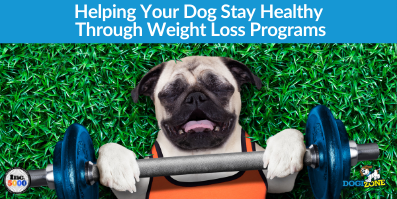Helping Your Dog Stay Healthy Through Weight Loss Programs
This year, Pet Obesity Awareness Day is October 14 so in celebration of this day, and to help pets that may have gained a pound or two over this COVID-19 crisis, setting up a dog weight loss programs and exercise for routine for your dog is a great way to get pets and people back in shape. 
This same routine or focus on diet and exercise is a simple way to prevent issues with obesity. Any breed of dog can gain weight with lack of exercise and too many treats between meals, but some dogs are prone to weight gain.
Specific breeds or crosses are more likely to put on weight. This is partially due to genetics, aging, and the natural tendency of these dogs to become more sedate couch potatoes as they mature. The breeds most often linked to weight gain include Labradors, Basset hounds, Dachshunds, Golden Retrievers, Pugs, Rottweilers, Boxers, and Bulldogs. Of course, any breed that is allowed too many treats, unregulated access to food, or dogs fed poor quality food can become obese in a very short period of time.
Exercise is Important
One of the best ways to prevent dogs from gaining weight is to have an appropriate exercise routine. It is a mistake to assume a dog left in the yard or in the house when you are at work is actually moving about and staying active. Most dogs find a comfortable spot and sleep, which means they need routine walks in the morning and at night to burn calories and keep their metabolic and digestive systems functioning.
How long and how intensely to exercise is based on the dog. Age, activity levels, size, and other factors all come into play. Surprisingly, giant breeds such as the Great Dane, Bullmastiff, Irish Wolfhound, and the Great Pyrenees need less routine exercise than breeds such as the Border Collie, Dalmation, Siberian Huskie, Russell Terrier, Welsh Corgi, or most of the Retriever and Spaniel breeds.
For overweight pets, always start dog weight loss programs short and slow on any exercise routines. Just like people, dogs have to work up to longer or more intense jogs or runs. Start with a walk around the block, gradually increasing the pace and the distance over a few weeks and months.
If a dog shows any sign of pain, stiffness, or discomfort with increased exercise, go back and start slowly. Those extra pounds are hard on joints, and taking it slow allows the dog to build up muscle while shedding extra pounds.
Some dogs with weight issues, particularly breeds with long backs or dogs with joint health issues, benefit from exercise in water. Walking in shallow water or swimming is a safe way to provide exercise without additional strain on the spine. These dogs should always have a human with them when swimming to provide support and safety during the exercise.
Dietary Changes
Dog owners need to consider all the added treats and snacks when considering the dog’s daily dietary intake. Rather than commercially prepared dog biscuits, switch to a health piece of broccoli, carrot, pear, apple, or a favorite fruit or vegetable. Try different options with your dog and see what works best.
Other good snacks include homemade biscuits that are free from any byproducts or sugars, or small pieces of boiled chicken or beef. Just remember to keep any treats to about 5% of the daily food intake for your pet.
If you are feeding free choice, limit your dog to a morning and evening feeding, removing any unconsumed food after about 20 minutes. Look at the manufacturer’s recommended feeding schedule, and measure your dog’s food to avoid overfeeding. Wet foods are often provided to dogs in portions beyond what the manufacturer recommends, and they can result in weight gain.
There are different options in weight loss and weight management food on the market. Talk to your vet or do your research to choose the food option that is best suited to your dog’s age, activity level, and nutritional needs.

